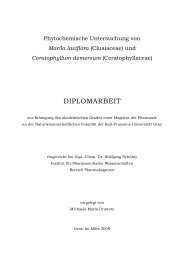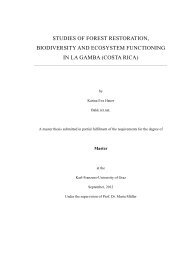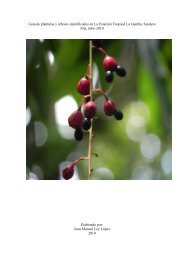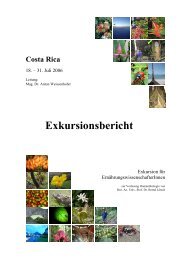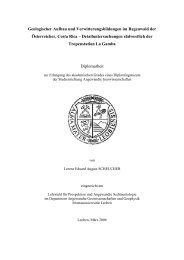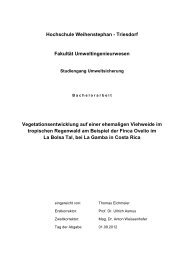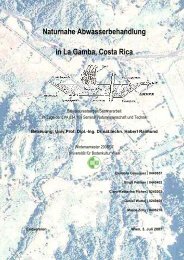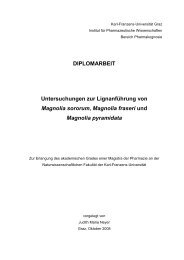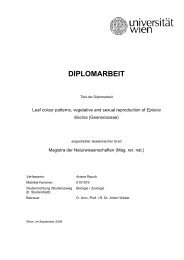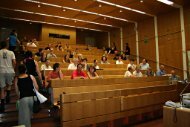Die Tropenstation La Gamba
Die Tropenstation La Gamba
Die Tropenstation La Gamba
Sie wollen auch ein ePaper? Erhöhen Sie die Reichweite Ihrer Titel.
YUMPU macht aus Druck-PDFs automatisch weboptimierte ePaper, die Google liebt.
<strong>Die</strong> „<strong>Tropenstation</strong> <strong>La</strong> <strong>Gamba</strong>“ in Costa Rica – Wissenschaftlicher Bericht<br />
SCHEMBERA, E. The Legume Flora of the Golfo Dulce Rain Forests, Costa Rica.<br />
Univ. Wien,<br />
Diplomarbeit: Institut für Botanik<br />
Abstract<br />
So far, more than 65 genera with 165 species of the c. 670 genera and about 18.000 species<br />
of Leguminosae (or Fabaceae s.1.) have been collected on the Peninsula de Osa and in the<br />
region around the Golfo Dulce on the South Pacific coast of Costa Rica. Many of these are<br />
endemic to either Costa Rica or this area only (see below).<br />
Research on Leguminosae was performed in <strong>La</strong> <strong>Gamba</strong>, a village close to Piedras Blancas<br />
National Park, the so-called Esquinas Rainforest, in order to list discovered species and<br />
collect some basic data on habitats and ecology. A part of the time was spent investigating<br />
the Leguminosae inside Corcovado National Park in southern Costa Rica, which Piedras<br />
Blancas formerly was a sector of. The Bosque Esquinas stretches over 148 kM2 within a<br />
range of altitude of 0-745 m. Its vegetation is composed mostly of tropical wet forest,<br />
tropical moist forest, premontane wet and rain forests and includes marsh, mangrove and<br />
swamp forests, dhosting approximately 5000 species, among which are more than 700 tree<br />
species inside the park, a quarter of all the tree species found all over Costa Rica. During a<br />
10 months' period of research about 190 species of Leguminosae were collected, including<br />
the forest species as well as the most important cultivated trees and herbaceous plants.<br />
Among those the following species were endemic to Corcovado National Park / Bosque<br />
Esquinas or other parts of Costa Rica: Caesalpinioideae: Bauhinia bahiachalensis sp. nov.,<br />
Copaifera camibar, Cynometra hemitomophylla (Costa Rica), Macrolobium costaricense<br />
(Atlantic slope and Peninsula de Osa) Mimosoideae: Calliandra grandifolia (Esquinas),<br />
Inga golfodulcensis, Acacia allenii, Cojoba sophorocarpa (Carara, Corcovado National<br />
Park), Newtonia suaveolens, Zygia englesingii (<strong>La</strong> Selva, Provincia Heredia and Peninsula<br />
de Osa). New species or new registrations at that time were Bauhinia bahiachalensis sp.<br />
nov., Dalbergia frutescens sp. nov., Inga capitata. In order to identify those species<br />
collected as sterile samples, a new key based on vegetative characters was developed,<br />
following the example of both, A.H. Gentry and N. Zamora. The identification of species<br />
growing and documented in the area should thereby be possible even without flowers or<br />
fruits, species that occur outside the Golfo Dulce region are not included. Ecological<br />
observations were made concerning habitats and strategies of Leguminosae inside the forest<br />
and in gaps or open areas.<br />
Anschrift der Autorin<br />
Schembera Eva<br />
Altmannsdorferstrasse 164/1/15<br />
1230 Wien<br />
a8604148@unet.univie.ac.at<br />
87



